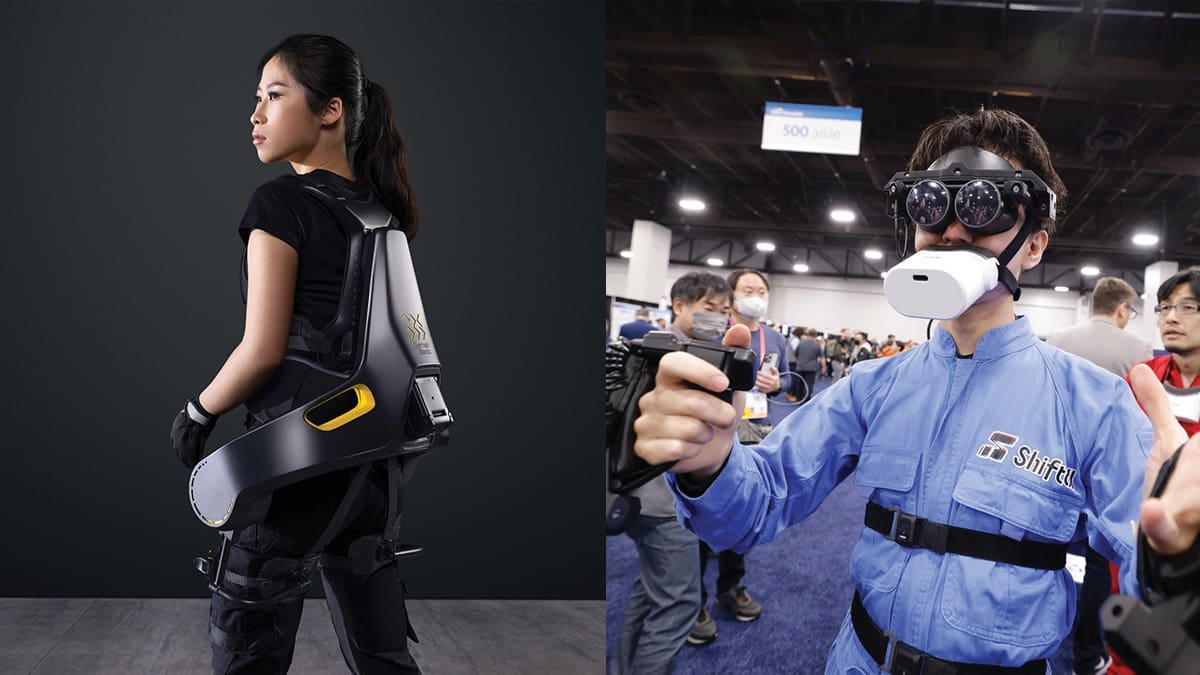CES 2023 – The 15 Pieces of Weird and Wonderful Tech Defining Our Future
CES has had a rocky few years as Covid has ravaged the live gathering scene. Now we’re back in full swing and we can finally check out all the devices that will send us into a digital reality in person! Reality was overrated anyway. Virtual Reality made a big showing this year in just about everything, even the cars wanted to immerse you in it. Speaking of the cars, they too came into their own at this CES, as they slowly blur the lines between horseless carriages and iPhones.
There were hits and misses practically everywhere. Let’s take a quick look at what this year delivered us.
1. Formovie 4K UHD Projector V10
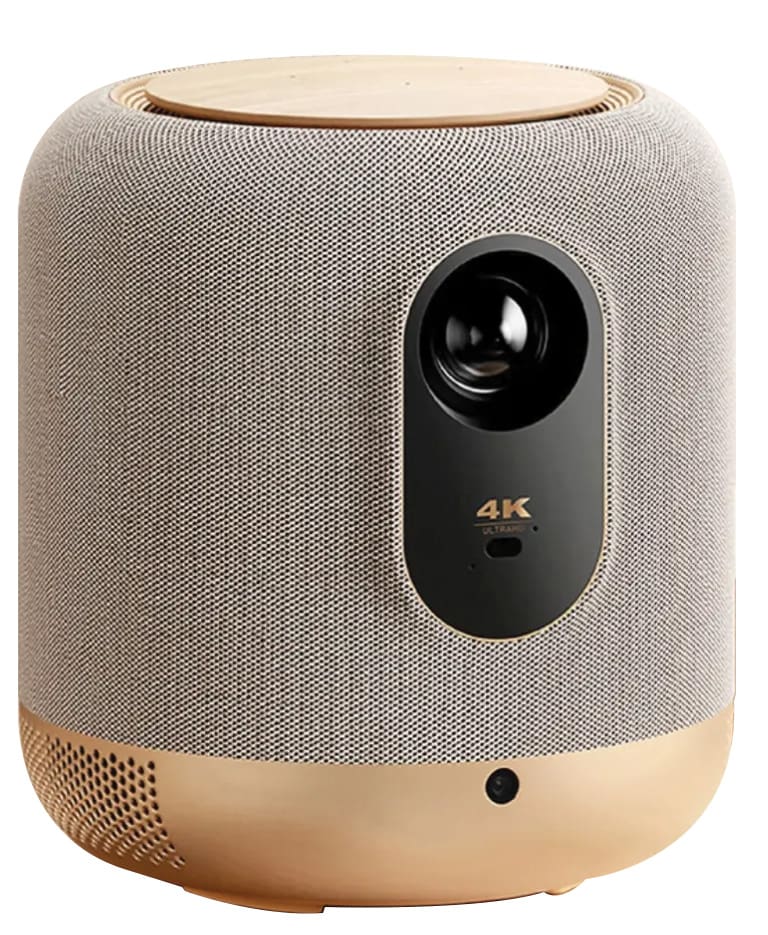
Disguised as an unassuming Bluetooth speaker the Formovie 4K UHD Projector V10 is really an honoree of CES 2023 Innovation Award. This is due to it really being a 4k 240Hz ultra-high refresh rate and low latency projector, which they tout as being perfect for gaming. With a latency as low as 12ms, I can see why. Brightness is 2500 ANSI Lumens and the audio experience is complimented by standard 7.5W full-range speakers with an independent 15W subwoofer included. With support for 360° Dolby surround sound It’s such a low fuss, high quality unit I can see why it impressed the judges at CES.
Pricing starts around NZ$ 1,810.
2. Apogee Exosuit
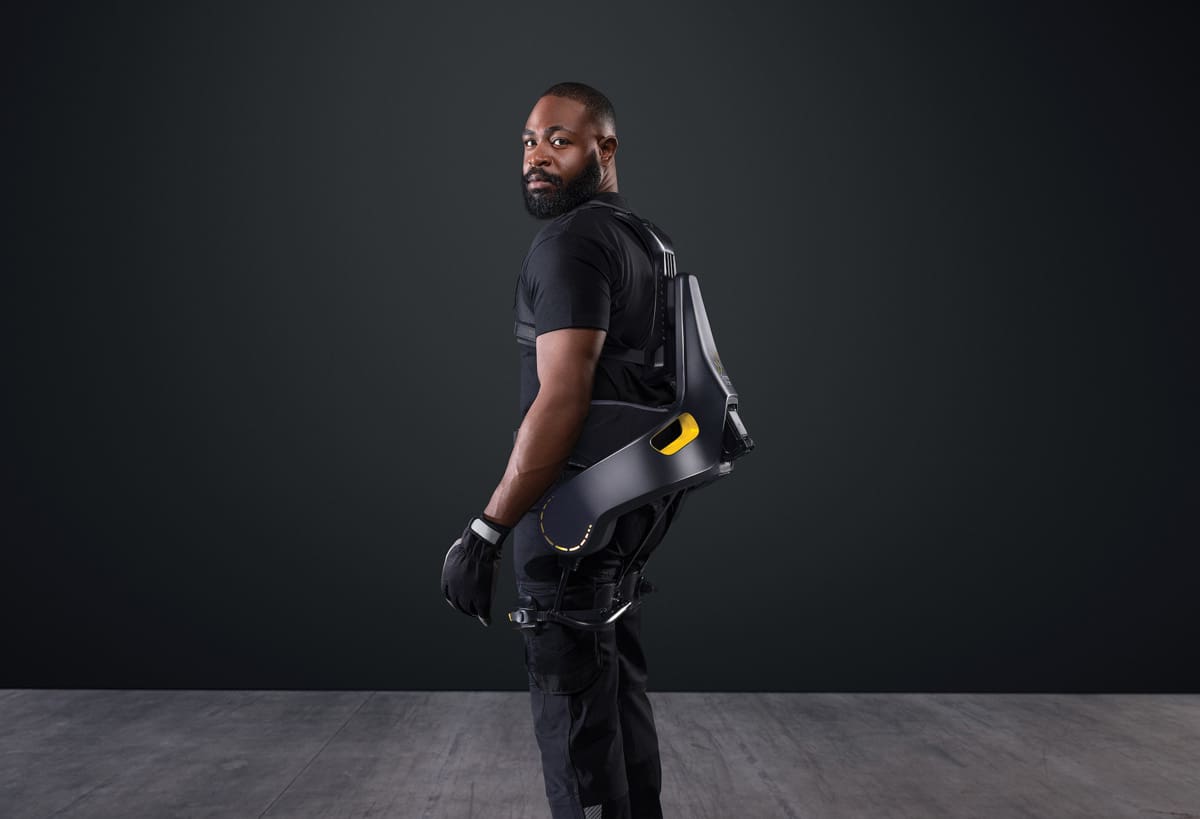
Building off what they learned from their Cray X exoskeleton from last year, German Bionic has developed a lighter, more intelligent piece of wearable tech. Dubbed the Apogee Exosuit, it can alleviate about 30kg off your lower back with each lift. If your back is already toast, then you know how good something like this would be. If your back isn’t in a constant state of pain, then you’re under 30 and you want to start thinking seriously about getting an exosuit now.
The suit also has walking assist, making life just that little bit easier. These are developed for commercial use, so don’t expect to see people doing the shopping with these things strapped on. While using the Apogee it analyses and stores data for later consultation, giving info that could lead to a safer more optimised working environment. Maybe they should have just added a little speaker that yells at you whenever you aren’t lifting with your knees.
3. Motion Pillow
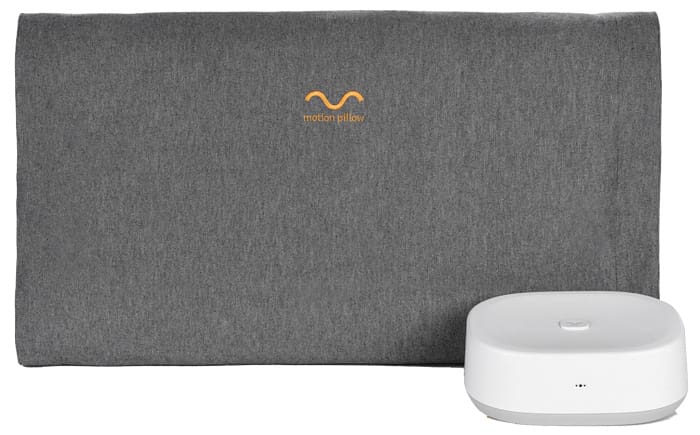
Outsource your partner having to boot you in the leg whenever you snore to a smart pillow! The Motion Pillow 2023 by 10Minds is a pillow rigged to a sound device that triggers when it catches you snoring too much. Airbags within the pillow will slowly and gently inflate to reposition your neck to stop the snoring. After your cutting wood sounds have calmed down it slowly deflates again, vastly improving your quality of sleep. According to their own stats, 93.7% of users found a recline in snoring, with a significant total decline in snoring in general. It can record your snoring so it can prove its worth later on, as well as give you other metrics. May no part of your life remain unmeasured.
motionpillow.com
The Weird

Progress is a non-linear path, and some paths lead in some bizarre directions. These following products make some bold choices. Some will pay off, some will fade away into obscurity by the time CES 2024 rolls around. But you have to give them all an A for effort, even if a screen on a chopping board is ridiculous.
Lenovo Yoga Book 9i
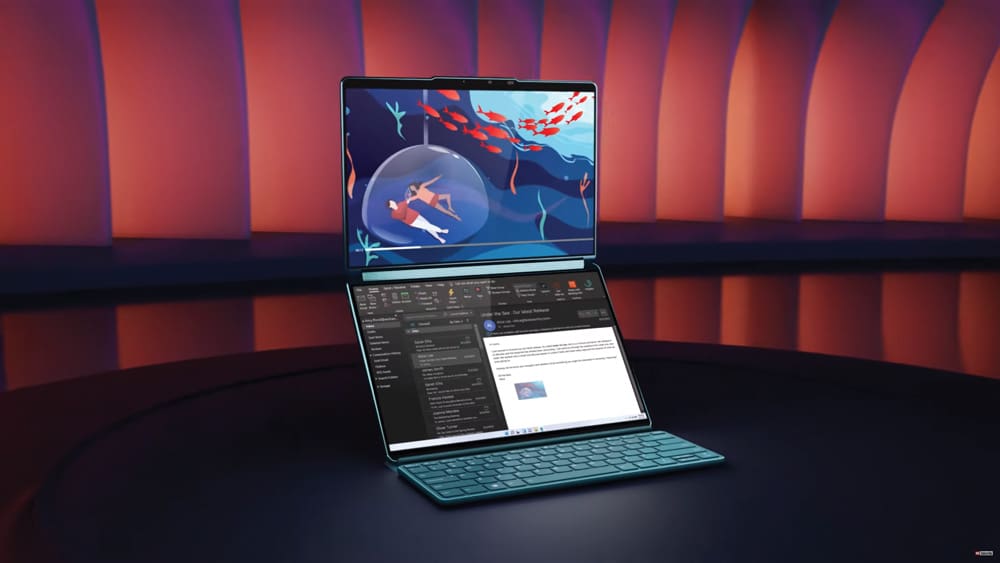
I’m sick and tired of laptops with just one screen. It feels so constrictive. I’m just looking for more in my laptop you know. Down with laptop monogamy, give me screen polygamy. Lenovo is offering a very interesting laptop tablet configuration in the form of the Yoga Book 9i. It comes with two full-sized 13.3-inch 2.8K OLED dual screens and a detachable keyboard. In the marketing material, it shows off its versatility with a range of awkward configurations that at first blush have zero utility. After some consideration though, and assurances that the kick stand is perfectly stable, it gets a little easier to see the benefits. Detaching the Bluetooth keyboard and using the bottom monitor as a drawing tablet while leaving references on the top screen does seem like an extremely useful use case. As is the dual portrait layout if you’re big on your word processing. Another posited use case is keeping the laptop in tent mode, so one screen is facing the board room with a presentation while the other faces you with the Powerpoint notes.
It can handle five finger touch, but drawing is best done with the Lenovo-designed Smart Pen stylus that neatly tucks away into the kickstand.
I give this product a two out of two screens, two thumbs up.
BLOK Smart Cutting Board
I’ve always hated having to plug my chopping board in at the wall, but fortunately this extremely useful BLOK Smart Cutting Board has wireless charging, so breathe easy. This is the first and hopefully last chopping board I have ever seen that comes with a built in screen. This display is used to display recipes and cooking tutorials. Fortunately you don’t need to run the whole thing under the tap when you’re done because the screen section can unclip from the high-quality dark walnut wood cutting section. Blok promises to deliver live and on-demand cooking classes. All controls are done via a smartphone app, so this thing doesn’t even eliminate a screen from the kitchen, it just adds another one. One day someone might make a chopping board with no screen in it and people will say, “Woah, so much more real estate to work with.”
Pricing is irrelevant, find out more at joinblok.com
SOL Reader

CES 2023 seems to be all about colliding unlikely tech together. First we were seeing E-Ink covered cars thanks to BMW, now we’re looking at an E-Ink Head Mounted Display. HMD’s for VR are all about high fidelity and insane refresh rates. Sol Reader is about freeing up your hands while reading a book. No longer will you have to hold your E-Reader at an awkward angle in bed, or dropping it on your face. Just lie down, put on your glasses and get lost in the imaginary world of your choice.
It uses wifi and Bluetooth and has USB-C charging. A single charge lasts about 30 hours. The experience of wearing the display is like seeing a square image of text floating in front of you. It doesn’t blast at you like a regular digital display so it still has all the advantages of E-Ink. The SOL Reader is still in development at this time and still requires some fine tuning, but if immersive reading sounds like your thing, sign up for updates at solreader.com
Pissed on, Not Pissed Off

French fitness manufacturer Withings has developed a curious piece of tech designed for you to take a slash on for a quick diagnostic test of your health. Don’t worry, it’s completely hands free! Called the U-Scan, this over glorified Toilet Duck can scan your business and let you know how your nutrition and hydration is going. It even tracks menstrual and ovulation windows, making it particularly useful for couples trying to add another human to the world, or just not get caught off guard if they aren’t already tracking. It sends all this information to your phone within a few minutes. As well as giving you a complete breakdown of your health, it can give you tips for improvement. Essentially, it makes every toilet break a journey of self improvement.
The Cars
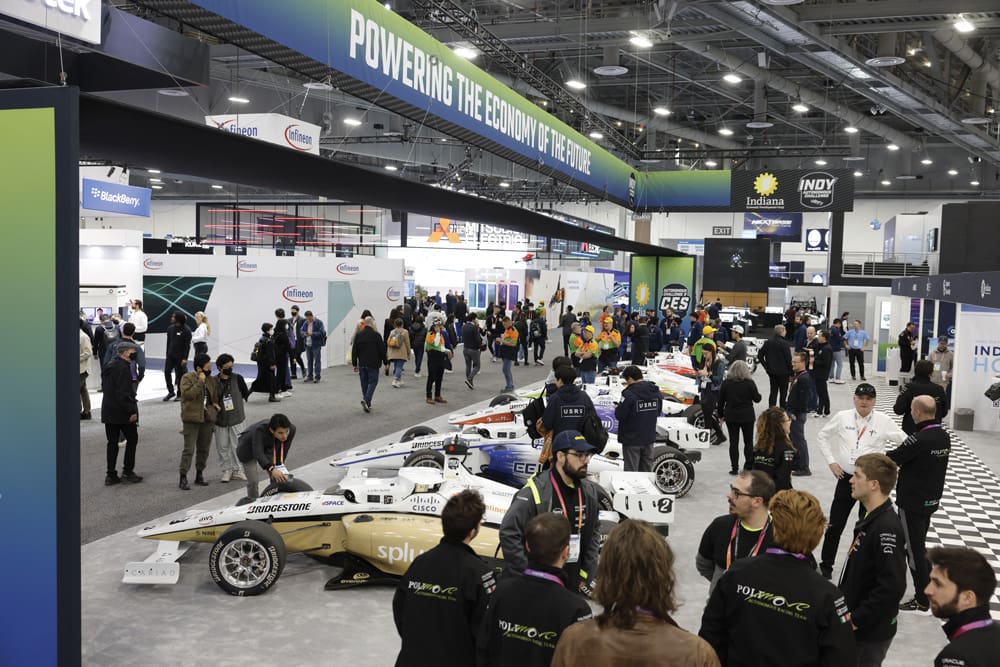
If CES is anything to go by, cars are about to get busy. While most motorheads are interested in seeing the kilometres per litre shrink, or torque and speed pushed to the max, the boffins at CES firmly plant their flag in the ground and say “No, what motorists really want to see is the sort of junk that makes gamers shell out for new cases and keyboards”. Lights, fancy lights, on everything. 2023 marks the year cars confidently stride into become consumer home technology. Exhibit A:
ZF Heat Belt
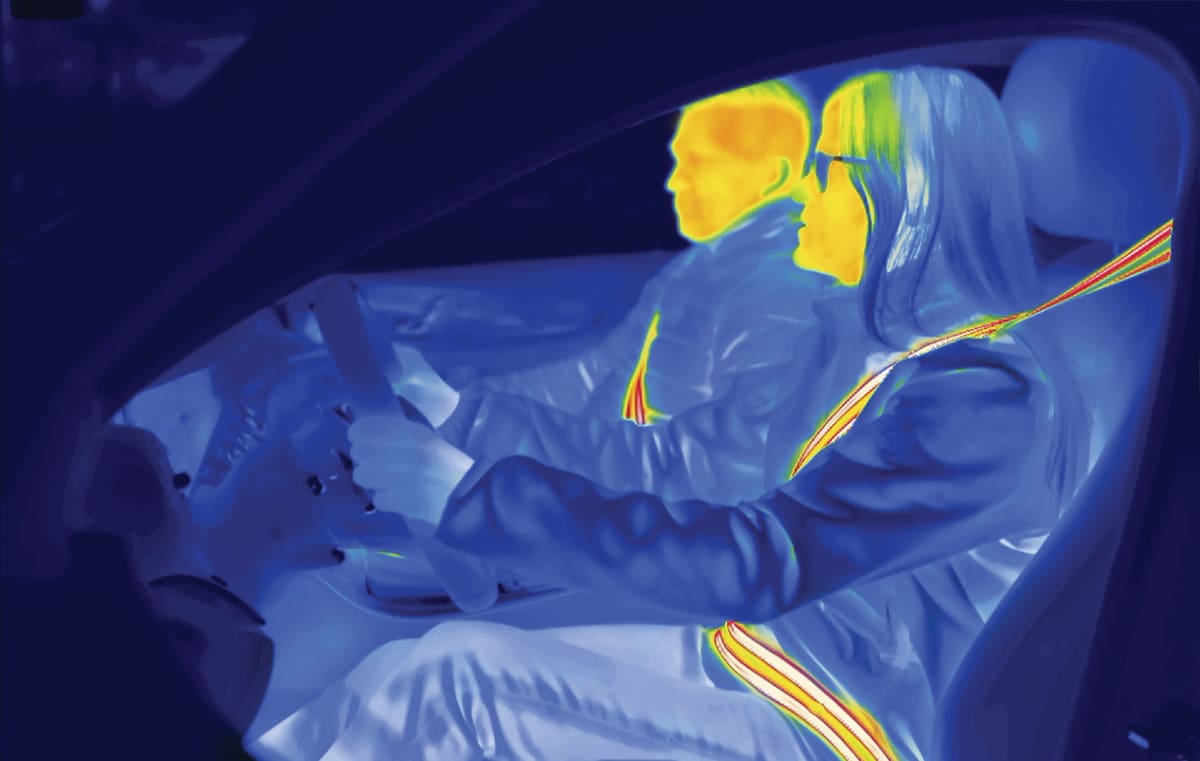
You’ve got two options for heating your car. Turn it into a hugely inefficient air fryer, or use the much more energy efficient heated sets. Now a new friend has entered the scene to accompany the seats. ZF is introducing Heat Belts which use just 70 watts to reach a surface temperature of 40 degrees centigrade. Alongside heated seats, this heating method could increase EV range by 15% if used instead of your conventional options. Personally, I don’t see making a little garbage fire out of receipts and discarded McDonald’s bags as using any electricity at all, but maybe that’s not considered “conventional” these days.
Sony and Honda Afeela

Never thought you’d ever see a Sony car did you? Well it’s here with the guiding hand of Honda and it’s packed with tech. Qualcomm provides the brains for the Afeela, and alongside Sony, it’s expected that this EV will leverage AI, augmented and virtual reality with a liberal dollop of AI to keep everything user friendly. It has over fourty sensors embedded in its exterior, making it more self aware than a teenager clinging to their chair at the school ball. All these lidars and ultrasonics will aid in autonomous driving. The thin light strip for the lights on the cars exterior takes queues from the rest of Sony’s consumer electronics by also doubling as a communication tool. The back lights apparently can be used to communicate in different colours, or post sports scores or other imagery. So prepare for a car cutting you off in traffic to tell you to get wrecked via its headlights sometime in the near future.
Pricing is being aimed at about the same level as other premium automakers like Mercedes-Benz and BMW. Afeela is still a concept at this point, but Sony wants to inflict it on us by 2026 with preorders starting in 2025.
The BMW i Vision Dee

The old guard weren’t about to let these jumped up tech companies just swan in and have all the glory. BMW had its own extremely eye catching model to show off. The BMW i Vision Dee. Dee offers different levels of virtual immersion. At its lowest settings, its windscreen can be used to display heads up displays and augmented reality. At its highest level, it becomes a full immersion virtual reality environment. Although this mode may only be useful when parked up, as playing Half Life while going 100km/h down the motorway is probably unadvisable.
The truly eye catching feature is its many panels of E-Ink plates on the exterior. E-Ink has only really found application with things like E-Readers, but there’s no reason that the tiny electrical charge that calls different pigments to the surface couldn’t be used for a complete colour change of, well, let’s just say a BMW. Using an app on your phone, you can call up to 32 different colours on a whim. This is perfect for getaway attempts or forgetting which is your car in the carpark.
The tech showcased in Dee will be found in the NEUE KLASSE from 2025 onwards. Dee can also emote on its exterior as well via her kidney grill and headlights. I guess it could do a sad face when it needs a tune up, or an angry face when someone dings one of the E-Ink panels.
Verge TS Ultra

By far the quickest way to catapult yourself down the tarmac is on the Verge TS Ultra, an electric motorbike with altogether too much power for its own good. The Verge TS has cleverly put the electric motor into the back tyre itself, allocating the weight distribution is physically low as possible. Its hubless design has also removed all the usual moving parts of chains and cogwheels, allowing this bike to fit into the world of tron seamlessly. Without all these usual moving parts you aren’t going to have to worry about gear box oil and cooling liquids. Just drive it.
It’s packing 1200 Nm of torque, can hit 100km/h in just 2.5 seconds and has a range of up to 375km. Fast charging the 20.2 kWh battery apparently only takes 35 minutes, with 80% achievable in just 25 minutes.
The Augmented

Augmented and Virtual Reality fever still grips the industry as Facebook’s burning hype train continues to bring attention to the space. I don’t think Facebook will bring the future of the Metaverse, but plucky upstarts just might.
The Brelyon
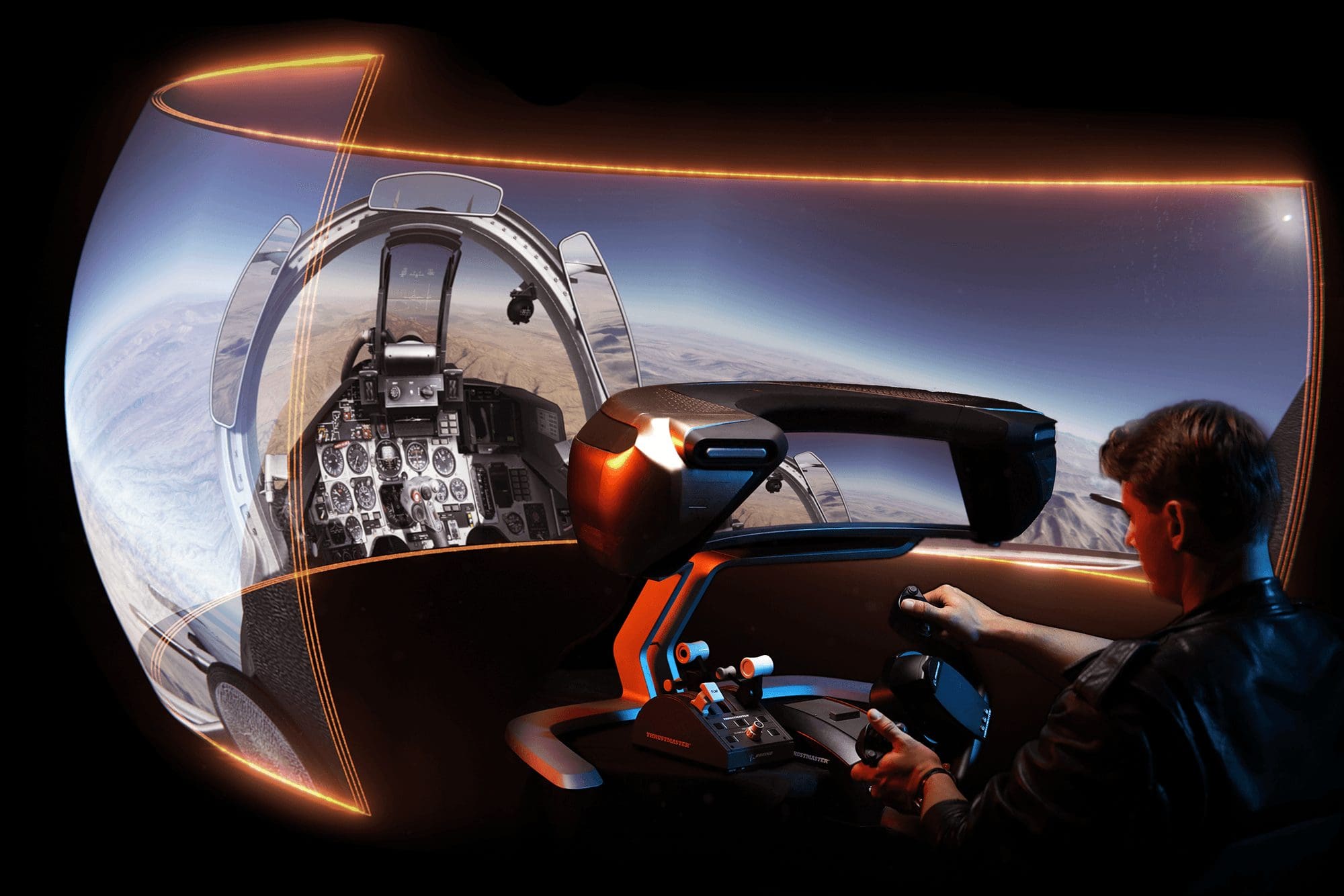
People tend to think that to enter VR, you HAVE to have something strapped to your face or implanted in your brain. But if we expect VR to be a standard working environment, we need a far more casual solution. The Brelyon is one such solution. This monitor is an incredible experience that delivers a tidy 110 degrees of horizontal FOV (a Quest 2 hovers around 100 degrees) as it wraps around your vision. It doesn’t take up much space. Looking through its 30” aperture is like gazing through a window to a 122” screen five feet away. The screen is vibrant with an amplified 700+ nits brightness in native HDR, 144Hz, and 4K base resolution. It’s like the tardis of monitors. The newest model shown off at CES is the Brelyon Fusion which blurs the lines between headset and monitor even further with Synthetic Aperture technology and spatial audio. It’s being dubbed the world’s first 8K desktop virtual display.
“Brelyon Fusion allows the blending of light to scale field-of-view in a new way that achieves multiples of resolution,” says Barmak Heshmat, CEO and founder of Brelyon. “This kind of new lightfield expansion innovation really allows us to think of light as pieces of LEGO blocks that can computationally be built to create a more immersive screen.”
The experience builds upon the company’s lightfield tech, Brelyon’s Ultra Reality, which uses precise wavefront engineering to create a massive field of view with true optical depth layers.
Put in simple terms, testers of the device at CES report not being able to tell how far the monitor is from their face as it creates a true feeling of depth looking into the screen. The difference between using this and going to a 3D movie is that you generally feel like things are coming out of the screen like a popup book, while with the Brelyon it feels like you’re falling INTO the scene. Outside of being a more casual, non-nauseating way of interacting with VR environments, this monitor is going to become a must buy for simulation fans. Any motorsport gamers, Flight Simulator, or Elite Dangerous truckers should definitely keep this on their Christmas wishlist.
13. VIVE XR Elite
Vive has reigned as king for the discerning VR user in the past, it’s time for it to reclaim the crown with its new standalone Vive XR Elite. With two hours of battery life, it has a hotswappable battery pack extending playtime for as long as you require.
With 1920×1080 per eye, it has a combined resolution of 3840 x 1920. It has passthrough and a design that accommodates any sort of setup you might be gunning for. Whether it be a wired PC setup, standalone, or even a more chill experience that replaces the back strap turning your headset into a pair of glasses that you can power via the tether. I guess this is best for more stationary AR passthrough experiences and movie watching. It has 128gb space, 90hz refresh rate and 110 degree FOV. Four cameras act as your inside out trackers. At 625g, it’s lighter than a Meta Pro headset. If you were looking for a premium standalone headset that is built outside the Meta ecosystem, then the XR Elite should be at the top of your list.
14. Onyx Argo
We’ve seen regular drops of brands developing glasses with cameras built in, but true smart glasses for augmented reality is where it’s really at. And the tech hasn’t been standing still since Google Glass. The new trend these days are XR/AR waveguides in what look like typical lenses. Trying to put this simply. Nanoguides within the glass (or plastic) lens help direct the light from the projector in the frame. Doing this right means you can get a decent viewing area in front of the eye without undue amounts of bulky projection equipment hovering conspicuously in the corner of your glasses.
Onyx was an honoree at the CES Innovation Awards for Argo, the first see-through, all-in-one binocular smartglasses with full-colour optics bright enough for indoor and outdoor use. The system has inside-out tracking capability, an advanced centre camera with optical/electronic image stabilisation, and is preloaded with DigiOS – an Android 12 AOSP based OS optimised for hands-free, body-independent controls.
It has a hot swappable battery on the frame, Wifi 6GHz capable, a Snapdragon XR2, and 6dof inside out tracking cameras.
Argo is targeted as an enterprise-lite-industrial wearable computing device, but we may be seeing Onyx’s state-of-the-art holographic waveguide and micro-projection technologies in consumer tech real soon.
15. Wi-Qi
While I still occasionally get premium gadgets that don’t have wireless charging, the tech world is marching ahead to a braver, better future. Wi-Charge is rolling out a completely wireless wireless charging pad called Wi-Qi. The pad is remotely powered by Wi Charge’s AirCord which can continuously pump power into multiple devices within a 10 metre cone. The AirCord can be mounted in a recessed light fixture slot to provide good line of site anywhere in the room. The transmitter converts electricity into safe infrared beams, which are then delivered to the receiver embedded in client devices. The receiver converts the infrared energy into electricity, which is used to charge the internal battery or super-capacitor. The receiver also sends telemetry data back to the transmitter, including battery status, usage statistics, and even billing information if it’s relevant to the setting (obviously not if this is a home job).
Widespread adoption of wireless charging like this will enable wearables in the future to have more grunt with less weight. No more having to lug around a bunch of lithium ion on the back of your head to get VR going, or dainty AR glasses chugging.
wi-charge.com
The Future of Mobile
As phones bump up against the hard limits on the size they can be without being jeered at for being a phablet, Samsung has been doing its best to extend real estate anyway. We’ve seen foldables become an absolute reality these last few years but now it’s time for the next step. Samsung illustrates that step with the Flex Hybrid OLED mobile screen.
Not a device at this stage, the Flex Hybrid is a concept of where they want to take things next. It folds AND slides. It starts off as a compact mobile size of something like 4.2”, then folds out to a 10.5” 4:3 display. From there it slides out the other side expanding the screen to a 16:10 12.4” display. Essentially you could be carrying around a 12.4” display in your pocket at all times.
We’ll have to wait and see how this tech ends up being used in a proper consumer product. Interestingly, a very similar product is already rolling out called the Tecno Phantom Vision V, which does the same outer screen as the Samsung Fold when its closed, and includes the extending screen size like the Flex Hybrid when it opens.

